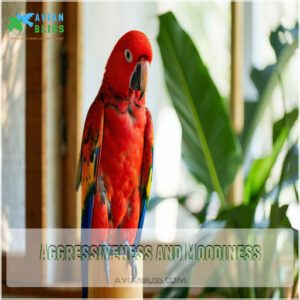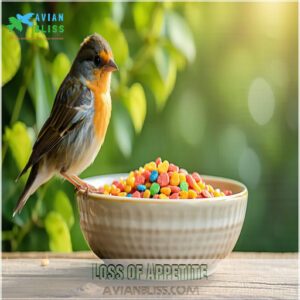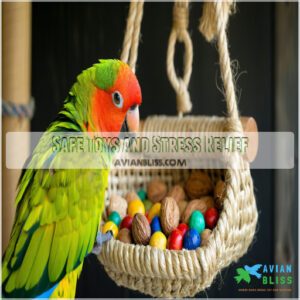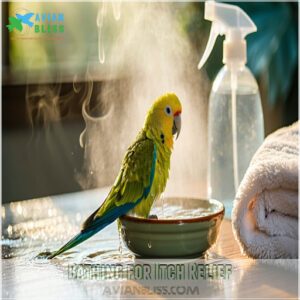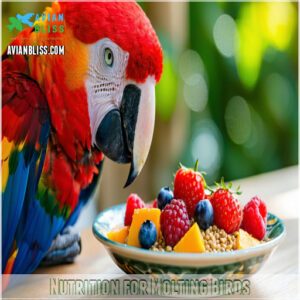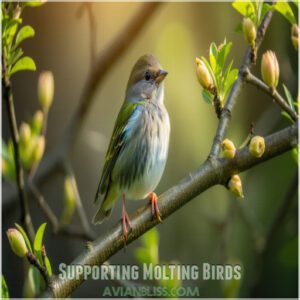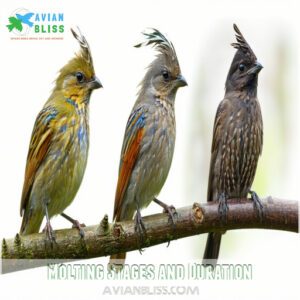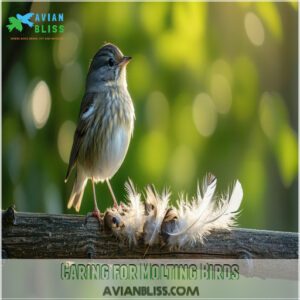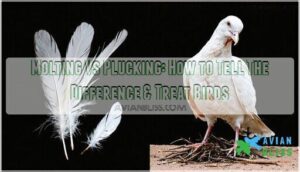This site is supported by our readers. We may earn a commission, at no cost to you, if you purchase through links.
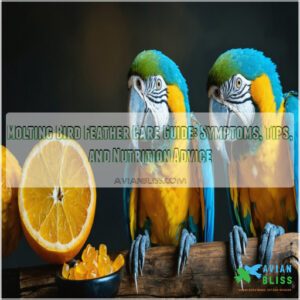
During this process, feathers fall out and grow back, which can make your bird itchy, stressed, and even grumpy.
Offer extra protein-rich foods like eggs or cooked chicken to support feather growth.
Regular baths or gentle misting can soothe itchy skin and help with loose feathers.
Keep their environment calm, avoiding loud noises or big changes.
Provide safe toys for distraction, and handle them gently—they’ll appreciate your patience.
Molting usually lasts a few weeks, so hang in there, every new feather marks progress.
Table Of Contents
- Key Takeaways
- Bird Molting Basics
- Molting Symptoms
- Molting Care Tips
- Nutrition for Molting Birds
- Molting Frequency and Timing
- Environmental Factors
- Supporting Molting Birds
- Molting and Behavioral Changes
- Molting Stages and Duration
- Caring for Molting Birds
- Frequently Asked Questions (FAQs)
- How do you take care of a molting bird?
- Should I help my bird with pin feathers?
- How to treat feather loss in birds at home?
- What time of year do birds molt their feathers?
- How can I tell if molt is abnormal?
- Do different foods support specific feather types?
- Can molting disrupt a bird’s sleeping patterns?
- What toys help reduce molting-related stress?
- How do wild birds cope with molting challenges?
- Conclusion
Key Takeaways
- Boost your bird’s diet with protein-rich foods like eggs or cooked chicken to support feather growth during molting.
- Provide regular baths or misting to ease itchiness and help with loose feathers.
- Minimize stress by keeping their environment calm, offering safe toys, and handling them gently to support feather growth.
- Watch for signs of abnormal molting, like bald patches or extended molting periods, and consult a vet if needed.
Bird Molting Basics
Molting is when your bird replaces old, worn-out feathers with new ones, keeping them healthy and ready for flight.
It’s a natural process triggered by changes in seasons, hormones, or even their life stage.
Feather Growth Process
Understanding the feather growth process helps you support your bird better.
Feathers grow in specific stages during molting cycles:
- Old feathers shed, making room for new feathers.
- Pin feathers (tiny new ones) start forming.
- Blood nourishes growing feathers, making them sensitive.
- Feathers harden and develop proper texture.
- Fully developed new feathers replace the old ones.
The process of feather growth is crucial for the overall health and well-being of your bird, and recognizing these stages can help you provide the necessary care and support during the molting process.
Molting Triggers
Feather growth doesn’t last forever, and that’s where hormonal changes and environmental stressors kick in.
Shorter days, cooler weather, and even nutrient deficiencies can signal a bird it’s time to molt.
Wild birds notice tiny seasonal changes, syncing their molting patterns perfectly.
Pet birds? Artificial light messes with their biological clock, making their molting season less predictable.
For further information, explore this detailed guide to molting birds to understand the process of molting birds.
Complete Vs Partial Molting
Some birds go through a complete molt, shedding all feathers at once, while others have a partial molt, replacing just a few.
These molting patterns depend on species and seasons, fitting into natural molting cycles.
A complete molt helps prep for migration or harsh weather, while a partial molt focuses on small updates, like freshening worn plumage for ongoing bird development.
Understanding the bird molting process is essential for providing the right care and support during this critical phase of a bird’s life.
Molting Symptoms
When your bird starts molting, you’ll notice scattered feathers, changes in mood, and even a smaller appetite.
These are normal signs, but they can make your feathered friend a little stressed, so it’s important to watch closely and offer extra care.
Aggressiveness and Moodiness
Molting stress can make your bird a bit cranky, and it’s not their fault.
Hormonal shifts and feather stress often cause mood swings and even aggressive behavior.
Here’s how you can help:
- Stay calm; avoid reacting to irritability.
- Offer emotional support with soothing words.
- Use safe toys for distraction.
- Limit handling during avian anxiety episodes.
- Keep their space peaceful.
Note: No additional text or explanations are provided as per the instructions. The response only includes the reorganized text.
Loss of Appetite
When molting, birds often refuse food due to stress and discomfort.
You might notice your bird eating less or skipping meals entirely.
This is normal, but keep an eye on hunger signs or nutritional deficits.
Boost their molting diet with appetite stimulants like warm, soft foods.
A balanced meal keeps their health steady while feather regrowth drains energy.
| Symptom | Cause | Effect | Solution | Tips |
|---|---|---|---|---|
| Food refusal | Stress | Nutritional deficits | Offer soft, warm foods | Observe eating habits |
| Weak appetite | Energy demands | Weight loss | Add appetite stimulants | Provide protein-rich foods |
| Skipping meals | Mood changes | Nutritional gaps | Increase food variety | Rotate bird nutrition |
| Energy loss | Feather growth | Sluggish behavior | Offer high-energy foods | Make certain consistent feeding schedule |
| Eating habits | Discomfort | Health concerns | Monitor hunger signs | Keep fresh foods accessible |
Scattered Feathers
When feathers start scattering everywhere, it’s one of those unmistakable molting signs.
Your bird’s molting process means their old, worn-out feathers are making way for fresh ones.
It’s natural but can look messy!
Feather loss doesn’t mean plucking behavior unless it’s excessive or patchy—then, it’s time to check.
Focus on feather care through gentle bird grooming to support their feather health.
Molting Care Tips
Taking care of a molting bird means being patient and helping them feel more comfortable during this tough time.
From offering safe toys to providing soothing baths, there are simple ways to keep your feathered friend happy and healthy.
Patience and Understanding
It’s tough watching your bird struggle during molting, but your empathy makes all the difference.
Be patient and offer emotional support through gentle handling and a soothing voice. If they’re cranky, don’t take it personally—stress management is key for bird comfort.
Providing the right best avian nutrition can also help alleviate some of the stress associated with molting.
- Respect their “me-time.”
- Approach calmly and quietly.
- Avoid forcing interaction.
- Offer simple molting support daily.
Safe Toys and Stress Relief
When molting makes your bird cranky, safe toys for relaxation can be lifesavers.
Soft feather toys or stress balls can distract from discomfort, while calming aids like foraging puzzles keep them busy.
Gentle scratching helps soothe itchy spots, easing molting stress.
Always rotate toys to avoid boredom—anything that eases stressors counts as molting support for your feathered friend.
Bathing for Itch Relief
A quick splash can do wonders for your bird’s molting discomfort.
Regular bird baths or misting sessions provide itch relief and help with feather cleaning.
You can also purchase specialized bird bath spray products for enhanced cleaning and care.
Use warm water for effective skin soothing, and keep it gentle.
Try different bathing techniques like shallow dishes or mist sprays.
This simple water therapy supports feather care and grooming, leaving your bird feeling refreshed.
Nutrition for Molting Birds
When your bird is molting, a nutrient-rich diet is key to supporting healthy new feather growth.
Focus on offering protein-packed foods, like eggs or cooked lentils, along with colorful veggies for essential vitamins.
Balanced Diet Importance
Your bird’s balanced diet is the backbone of its molting journey.
Nutritional support is key to keeping feather health on track.
Focus on meeting their dietary needs by offering a variety of foods rich in nutrients like vitamins and protein.
A well-rounded bird diet keeps feather growth steady and your feathered friend feeling strong.
Protein-Rich Foods
A bird’s protein needs skyrocket during molting.
Offer egg nutrition—scrambled or hard-boiled—for an easy protein and vitamin A boost.
Try sprouted seed benefits and cooked quinoa for variety.
Meat supplements like tiny chicken bits or fish oil add healthy fats and essential nutrients.
Rotate these into the bird diet to keep growth steady and provide necessary nutritional support.
Vitamin Supplements
Protein helps, but vitamins are a game-changer for molting birds.
Molting supplements like vitamin A, D, and E boost feather health while supporting their stressed immune systems.
Consider adding natural molting supplements such as herbs, kelp, or protein-rich options.
Add color-rich vegetables, or try bird-safe natural supplements like kelp or garlic.
Liquid calcium with vitamin D3 can help if sunlight’s lacking.
A personalized feather care guide inspires better bird nutrition habits.
Molting Frequency and Timing
Molting happens once or twice a year for most birds, but the timing can vary a lot depending on the species, season, and even where you live.
Spring and fall are the most common molting seasons, helping birds stay ready for breeding or keeping warm in colder months.
Annual Molting Cycles
Every bird species has its own molting cycle.
Most molting birds go through one or two cycles a year, shedding and growing feathers as part of the natural molting process.
Bird hormones and seasonal triggers, like changing daylight, kickstart these molting patterns.
Cycle variations depend on their environment or needs, ensuring healthy feather regrowth during the right molting season.
Spring and Fall Molts
Seasons play a big role in molting cycles.
Spring and fall molts prep your bird’s feathers for changing weather or migration.
It’s all about timing and feather health.
- Spring molts often follow breeding season, supporting fresh feather growth.
- Fall molts help birds handle colder, tougher climates.
Paying attention to seasonal changes lets you track your bird’s molting patterns easily.
Species-Specific Molting
Regarding molting patterns, bird species set their own schedules.
Some like chickadees molt yearly, while buntings mix it up with one full and one partial molt.
Marsh Wrens? They’ve got two complete molting cycles.
Feather types and bird genetics shape these routines, so knowing your bird’s molting species helps you prepare for their unique needs.
Environmental Factors
Your bird’s environment plays a huge role in how smoothly molting goes, so it’s important to get it just right.
Things like lighting, temperature, and humidity can either help new feathers grow in beautifully or make the process much harder.
Lighting and Temperature
Keeping your bird cozy during molting means balancing lighting systems and temperature control.
UVB lighting helps birds synthesize vitamin D, supporting healthy feather growth.
Avoid drafts and sudden temperature changes—steady thermal comfort is key.
Stick to a natural light cycle, but don’t overdo artificial light.
Warm heat sources, like ceramic heaters, guarantee your bird stays stress-free and comfy.
Humidity and Air Quality
Good air quality and proper humidity control work wonders during the molting process.
Aim for 50-70% humidity to keep feathers healthy and prevent dryness.
Use ventilation systems and air purification to maintain clean, fresh air.
Balanced moisture levels reduce itchiness and support feather maintenance.
Don’t forget, consistent humidity is key to making your bird more comfortable during molting, with proper humidity control and clean, fresh air being essential.
Artificial Light Impact
Artificial light messes with birds’ circadian rhythms, throwing their molting, sleep, and feeding cycles out of whack.
Light pollution, like bright outdoor lights at night, can disrupt their natural light cycle and behavior.
To help molting birds, stick to UV lighting that mimics their needs, keep the light spectrum gentle, and make certain they rest in dim, calming spaces.
Supporting Molting Birds
Molting can be tough on your bird, so it’s important to help them feel comfortable and cared for.
By offering calming support, gentle feather care, and avoiding too much handling, you can reduce their stress and ease the process, which involves providing gentle feather care.
Calming Measures
Molting stress can make your bird cranky, but bird calming is doable.
Create a peaceful environment with soothing sounds—soft music works wonders.
Try relaxation techniques like a gentle massage around the neck or head.
Calming oils, like lavender, in tiny diluted amounts can also help.
Keep things calm to avoid feather plucking, and always prioritize their comfort while they molt.
Feather Care Assistance
Feather preening is key during molting.
Gently help by scratching around pin feathers, where your bird can’t reach.
Use baths or misting for plumage conditioning and feather dusting—it relieves itchiness and supports healthy feathers.
Consider supplementing these practices with specialized feather care products to further enhance plumage health.
Avoid tugging or stressing sensitive areas.
Keep beak trimming tools nearby for emergencies, focusing on feather health to reduce discomfort and promote proper feather care during this delicate phase.
Reduced Handling
When your bird’s going through the molting process, handling can feel overwhelming for them.
Keep interactions gentle and minimal. A soft approach helps them stay calm and stress-free.
Here’s what to do:
- Limit handling to necessary moments.
- Create a calm environment, free from loud noises.
- Offer a quiet space for rest.
- Avoid petting sensitive pin feathers.
- Focus on healthy bird feather care.
Molting and Behavioral Changes
When your bird is molting, you might notice big changes in their mood and behavior, like irritability or unusual nippiness.
These shifts are normal, but it’s important to watch for signs like feather pulling or stress and know when to reach out to your vet for extra help.
Mood Swings and Irritability
When molting, birds can act grumpy, moody, or downright irritable—it’s like they’re having a feathery bad day!
Their hormones are all over the place, which leads to understanding these emotional triggers to help with stress management.
Try calming techniques, like soft music or gentle routines, to soothe them, and to provide proper care and support during this critical phase, recognize the signs of bird molting process .
Watch for these shifts in bird behavior, as outlined in the table below, to better understand their needs during molting:
| Mood Change | Possible Cause | Calming Techniques |
|---|---|---|
| Aggression | Hormonal stress | Quiet environment |
| Vocalization stops | Energy conservation | Gentle reassurance |
| Irritability spikes | Feather growth discomfort | Warm bath or misting |
Feather Pulling Behavior
Sometimes, birds deal with molting anxiety by feather plucking, which adds to their stress.
Feather loss from plucking can damage follicles, blocking future feather repair.
Help reduce molting anxiety by focusing on:
- Providing engaging toys to reduce boredom and stress.
- Checking for damaged feathers while gently managing pin feathers.
- Offering a calm routine to lower stress and protect those delicate feathers.
Consultation With Veterinarian
If molting problems seem off the charts—like feather loss leaving bare patches or unusual bird health issues—it’s time to get veterinary advice.
Avian experts can spot molting diagnosis signs that might baffle you.
| Observation | Possible Cause |
|---|---|
| Bare feather areas | Stress or poor diet |
| Feathers breaking easily | Nutritional deficiency |
| Red, inflamed skin | Infection or irritation |
Quick veterinary care can save your bird’s health.
Molting Stages and Duration
Molting happens in three main stages: pre-molting, active molting, and post-molting.
Each stage plays a key role in feather growth.
It can take anywhere from 5 to 12 weeks, so knowing what to expect during these phases can help you support your bird’s needs.
Pre-Molting Phase
Right before a molting bird starts shedding feathers, you might spot early molting signs, like increased preening behavior or a sudden uptick in bird stress.
This pre-molting phase is your cue to adjust their pre-molting diet.
Add protein-rich treats like eggs or sprouted seeds to prep for feather growth.
Watch for subtle changes in your bird’s energy.
Active Molting Phase
The active molting phase is tough on your bird.
You’ll notice feather loss, mood swings, and even molting stress.
Their body works overtime on feather regrowth, so bump up bird nutrition with protein-rich foods like eggs or quinoa.
Molting pain can make them irritable, so keep things calm and let them rest.
Gentle baths help soothe itching during this molting process.
Post-Molting Phase
Once the molting storm passes, your bird enters the post-molting phase.
Feather regrowth is like fresh paint on a canvas—delicate and needing care.
Focus on:
- Gentle bird grooming to assist with new feather tips.
- Feeding protein-rich snacks for healthy feathers.
- Providing quiet spots for bird recovery.
- Avoiding overhandling to protect feather replacement.
- Monitoring comfort for proper feather growth.
Caring for Molting Birds
Taking care of a molting bird means watching for signs of stress and providing extra support to keep them comfortable.
You’ll need to adjust their diet, offer gentle care for their new feathers, and create a calm environment so they can rest and heal.
Daily Routines and Check-Ups
Start each day with Morning Checks—look for missing feathers or signs of stress.
Regular Feather Inspection helps spot issues early.
Add Daily Weighing to track health since weight loss signals trouble.
Here’s a quick breakdown:
| Task | Time of Day | Why It Matters |
|---|---|---|
| Morning Checks | Morning | Spot early signs of stress |
| Feather Inspection | Anytime | Promote proper feather care |
| Daily Weighing | Morning | Monitor health consistently |
These steps make your bird feel cared for daily!
Monitoring Health and Wellbeing
Keep an eye on your bird’s feather condition, checking for smooth, healthy feathers.
Watch for any signs of beak or eye issues like cracking or discharge.
Respiratory issues, such as wheezing, need quick attention.
Monitor their weight—too light or heavy signals trouble.
Pet bird care isn’t hard; just stay observant and keep those feathers glowing with care.
Adjusting Care and Support
As you’re keeping an eye on your bird’s health, adjust its care routine to match its needs.
Focus on Molting Stress Relief by offering a quiet spot, extra protein, and fresh veggies.
Feather Maintenance matters, so mist feathers gently or let them bathe.
Understanding the bird molting process is essential for providing proper care.
Supporting molting with patience and a cozy space makes a big difference in their comfort.
Frequently Asked Questions (FAQs)
How do you take care of a molting bird?
Ever notice your bird looking scruffier than usual?
During molting, focus on protein-rich foods, offer baths for itch relief, reduce stress with patience, and provide rest.
Watch for irritability—it’s tough growing all those feathers!
Should I help my bird with pin feathers?
Yes, gently help your bird with pin feathers, but only if they’re ready.
Use soft strokes or light scratching to avoid pain.
Pin feathers are sensitive, so watch for discomfort and don’t force it.
How to treat feather loss in birds at home?
Feather loss? First, check your bird’s diet—boost protein with eggs or quinoa, add leafy greens.
Provide regular baths to soothe skin and reduce stress.
Avoid overhandling, offer safe toys, and make certain plenty of rest.
What time of year do birds molt their feathers?
About 85% of birds molt every spring and fall, tied to seasonal shifts.
Spring molts prep for breeding, while fall molts ready feathers for colder months.
Timing can shift depending on species, climate, and migration.
How can I tell if molt is abnormal?
Watch for bald patches, skin redness, bleeding, or excessive feather loss.
If feathers grow back oddly shaped or molt lasts over 12 weeks, it’s likely abnormal.
Consult an avian vet to rule out illness.
Do different foods support specific feather types?
When your bird’s feathers need a little extra love, add protein-packed foods like eggs or quinoa for strong, sleek feathers.
This will help balance your bird’s diet, and tossing in colorful veggies for vitamins that boost vibrant plumage is also beneficial.
Balance makes everything shine.
Can molting disrupt a bird’s sleeping patterns?
Sure, molting can mess with your bird’s sleep.
Hormonal changes, stress, and discomfort from growing feathers might keep them restless.
Make sure they get quiet, dark spaces and extra rest to feel better.
What toys help reduce molting-related stress?
When feathers itch like crazy, try offering toys that soothe and distract, like soft chewable rope toys, shreddable paper, or foragers filled with treats.
These keep your bird busy, easing molting stress and irritation.
How do wild birds cope with molting challenges?
They hunker down in safe spots, conserve energy, and rely on extra food sources.
Some avoid long flights, focusing on rest and grooming.
Seasonal cues and balanced diets help them stay steady during this tough time.
Conclusion
They say, "Patience is a virtue," and it’s definitely true when caring for a molting bird.
Keep their stress low, offer protein-packed foods like eggs or cooked chicken, and make baths part of their routine to help itchy skin.
Handle them gently—this is a tough time for your bird.
Watch for mood swings and changes, and provide safe distractions like toys.
With proper care and this molting bird feather care guide, your bird will soon flaunt fresh, healthy feathers.
- https://complementosparaaves.com/blog/en/care-feathers-birds-time-moult/
- https://pangovet.com/pet-health-wellness/birds/molting-in-pet-birds/
- http://web.stanford.edu/group/stanfordbirds/text/essays/Molting.html
- https://www.allaboutbirds.org/news/the-basics-feather-molt/
- https://vcahospitals.com/know-your-pet/molting-in-birds


